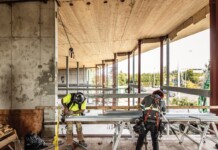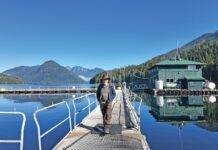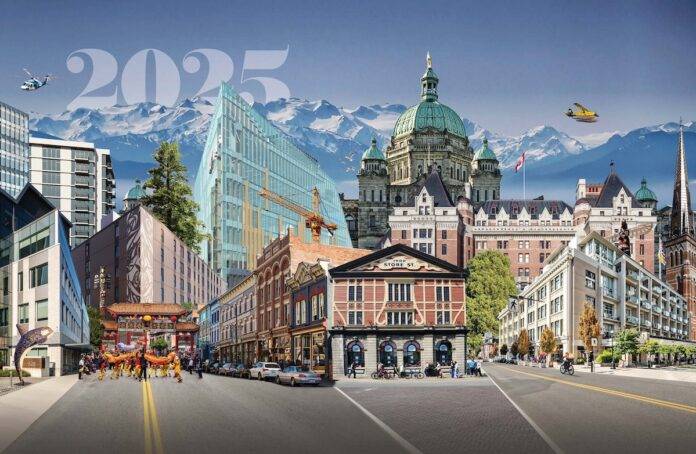The bad news? British Columbia’s economy struggled in 2024 and will continue to struggle in 2025. The good news? Vancouver Island — and the Capital Regional District in particular — will outperform the rest of the province. Meanwhile, in several sectors, trends that started this year or earlier will continue much the same into the next.
Overall, B.C.’s economy is “soft, struggling, weak, flagging [and] a little bit flat,” says Ken Peacock, senior vice-president and chief economist with the Business Council of British Columbia. The council expects the province’s gross domestic product to be less than one per cent next year, which by itself isn’t that concerning. But what is concerning is that the population is growing by three per cent per year. “So what that really means is most of our growth is being driven by population, and so that means per capita GDP is actually falling,” Peacock says.
That trend is likely to continue in 2025.
Another area the experts worry about is the intersection of housing, real estate and construction — not just because they comprise a major sector in southern Vancouver Island’s economy, but because they affect so many others.
Julie Sperber, president and CEO of the Vancouver Island Economic Alliance, refers to real estate and construction as “a bit of a double-edged sword.” It is one of Southern Vancouver Island’s largest GDP contributors. But wages haven’t kept up with the high costs associated with owning a house in the region. “So limited affordable supply and the rapidly increasing prices have deepened our housing crisis,” she says.
The housing shortage, along with a lack of skilled labour, a changing climate and concerns about street disorder, will likely affect the region’s economy for some time. To get a better sense of just how that will unfold, Douglas magazine talked to people in five key sectors — technology, the blue economy, agriculture, tourism and retail — to get a sense of what’s around the corner in 2025.
Technology
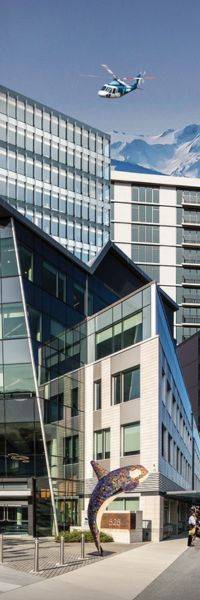 Technology is an industry that is invisible to many people, often selling globally rather than from local storefronts. But despite its lack of obvious physical presence, it packs a punch.
Technology is an industry that is invisible to many people, often selling globally rather than from local storefronts. But despite its lack of obvious physical presence, it packs a punch.
In 2023, the last year for which numbers are available, total revenues in Greater Victoria’s tech industry were estimated to be $5.9 billion, according to an economic impact study prepared for the not-for-profit Victoria Innovation, Advanced Technology & Entrepreneurship Council. Tech is also one of the largest private-sector employers in Victoria, employing more than 20,000 people, about 2,000 of whom are self-employed.
Companies range from aerospace and advanced manufacturing to marine technologies and online marketing. “We have a very diverse tech sector that’s in many verticals,” says VIATEC CEO Dan Gunn. “But often they’re micro-niche players that are in a very specialized space.”
Which is why tech companies often fly under the radar.
What brings tech companies to Victoria, in addition to the great location, is the fact there are two universities and a college here as well as a number of federal research facilities, including the Institute of Ocean Sciences, the Herzberg Astronomy and Astrophysics Research Centre and the Pacific Institute for Sport Education (formerly the Pacific Institute for Sports Excellence).
“So that’s bringing smart people and research,” Gunn says.
There is also a great community spirit where the early entrepreneurs are very supportive and mentor the newcomers.
Peacock believes one reason tech companies do so well is they don’t need a physical presence. There’s no land base associated with tech, so business owners don’t need to get a permit to build a structure as they would if they were developing a condo building.
“It is basically unfettered and unregulated,” he says. “So there’s almost a bias already where, if you’re going to build a company and invest, it’s much easier in the tech space.”
Tech Predictions
Positives: Generally, Gunn expects that 2025 will be a more stable environment for tech businesses than the past few years when investment and the job market were overheated. A less-heated environment, though, makes it more challenging to raise money.
Ongoing: There is continuing demand in the sector. “Everything’s still going digital,” Peacock says. “There’s demand for these services.”
Challenges: The VIATEC impact study identified affordable housing as the primary challenge for tech firms. Many companies have told Gunn that they are hiring people, but having a hard time finding them somewhere to live. Gunn hopes the recent changes to the province’s short-term accommodation rules, which are designed to add thousands of units to the residential housing market, may alleviate some of this challenge and make it easier for companies to hire good staff.
Blue Economy
 Consider the blue economy — defined by the World Bank as the sustainable use of the oceans for economic growth — the kid sister or brother to Victoria’s well-established tech sector. Companies in this sector are often startups still finding their way.
Consider the blue economy — defined by the World Bank as the sustainable use of the oceans for economic growth — the kid sister or brother to Victoria’s well-established tech sector. Companies in this sector are often startups still finding their way.
The idea is how to better use the oceans without exploiting them, says Jason Goldsworthy, executive director of Victoria-based Centre for Ocean Applied Sustainable Technologies. COAST was created in 2021 in recognition that oceans play a pivotal role, not only in climate health but also in terms of economic prosperity. Its goal is to help people with an idea turn that idea into a marketable product. Among its initiatives is matching marine companies with organizations such as the Royal Canadian Navy, Canadian Coast Guard and BC Ferries, which will help them test their products or even buy them.
In 2024, COAST held the first of what it expects to become an annual pitchfest, inviting companies to make their pitch to a panel of judges. Seacork Studio emerged as the winner for its groundbreaking concept of biodegradable acoustic panels made from seaweed.
Blue Economy Predictions
Positives: In September 2024, COAST opened its first co-working facility on Herald Street, a 7,000-square-foot space with a kitchen, coffee bar and telephone rooms, where companies in the blue economy can connect with each other — all at a subsidized rent. Goldsworthy expects to see this space foster collaboration and innovation, with the fruits of that collaboration “showing up in spades” in 2025.
Ongoing: COAST plans to focus on its Blue Pathways initiative, launched in 2024 to identify courses that teach the skill sets sought by companies in the sector. Prerequisites are a passion for the ocean and some knowledge or skill that can be used in the marine industry, such as data management or conservation.
Challenges: Goldsworthy lists regulatory uncertainty as a challenge facing the blue economy. But challenges are not obstacles in the tech startup space, he says, because anything worthwhile is difficult.
Agriculture
 While agriculture isn’t one of the area’s biggest economic engines, it is still an important part of the local economy and food security is always an issue for an island community, as well as a growing concern in a world affected by climate change.
While agriculture isn’t one of the area’s biggest economic engines, it is still an important part of the local economy and food security is always an issue for an island community, as well as a growing concern in a world affected by climate change.
Peacock calls agriculture a “good news story,” benefiting from the concern about local food security. On the other hand, VIEA’s Sperber worries that the industry is slowing. “We don’t really value our farmers,” she says. “And in our particular region of the world, real estate markets and the value of land actually play a role in agriculture not being able to expand.”
Simon Fowler, who is stepping in as head farmer at Dan’s Farm & Country Market in Saanichton, says both perspectives are true.
The value of land makes it infeasible for new farmers to buy land, so they tend to lease it instead, “which makes the razor-thin line of success or failure as a new or newer farmer that much finer,” Fowler says.
But the farm-to-table movement has made a difference. It has enabled Dan’s Farm and others in the region to grow higher-quality produce and charge more for it, meaning they are finally earning a livable wage.
At the same time, perhaps no industry is more affected by the changing climate. Island farms fortunately escaped the devastating winter cold that destroyed grape and fruit crops across most of the B.C. Interior in 2024, but no one is immune from the increased risk of storms, floods, fires and drought.
While agriculture isn’t one of the area’s biggest economic engines, it is still an important part of the local economy and food security is always an issue for an island community, as well as a growing concern in a world affected by climate change.
On the other hand, longer, warmer summers have the potential to increase overall yields and the kind of crops that can be grown here. Dan’s Farm, for instance, has invested in stone fruit trees, including peaches, that they would never have grown in the past, while others are experimenting with citrus and olives.
Agriculture Predictions
Positives: Sperber believes that B.C. will see greater innovation that will allow farmers to move away from the constraints of land-based farming, such as the use of greenhouses and vertical farming, where crops are planted in vertically stacked layers. This may not come to the fore in 2025, but she anticipates it will happen.
Unknown: The weather. Luckily, 2024 was a pretty good year weather-wise, Fowler says, with hot days in June and July to encourage growth, but not so hot that plants got burned. The late August clouds, though, limited growth of some crops that would normally produce well into October. Asking him to predict what 2025 will be like is — literally — asking Fowler to predict the weather.
Challenges: All across B.C. farms have been disappearing at an alarming rate as farmers retire with no family willing to take over. A 2023 RBC report found that 40 per cent of Canadian farm operators will retire by 2033, yet 66 per cent of producers have no succession plan. At the same time, the country faces an expected shortfall of 24,000 general farm, nursery and greenhouse workers. The report called it “one of the biggest labour and leadership transitions in the country’s history.”
Fowler alone has counted seven farms that have shut down just in his Saanichton neighbourhood. Even if land is in the Agricultural Land Reserve and leased to another farmer, there’s no guarantee it will be used for food production — often it is used for grazing or for marijuana crops, with a negative impact on food security. Over the next decade, Fowler says, there will be a steep decline in farming unless people start “taking up the sword.”
Tourism
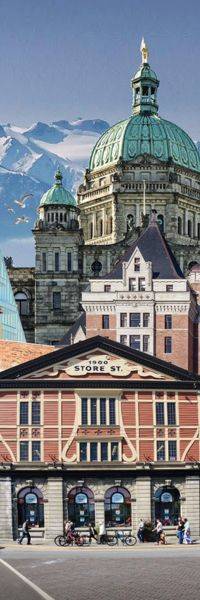 Tourism is one of Victoria’s biggest industries and 2024 was a good year. Paul Nursey, CEO of Destination Greater Victoria, believes 2025 will be a strong year, too, even though tourism is down across the province.
Tourism is one of Victoria’s biggest industries and 2024 was a good year. Paul Nursey, CEO of Destination Greater Victoria, believes 2025 will be a strong year, too, even though tourism is down across the province.
“We’ve been able to beat the pack, so we’re very pleased,” Nursey says.
There are a number of reasons for that, he says. One is the number of conventions — the most lucrative segment of tourism — coming to the city. Whether it rains or shines, or whether people feel like it or not, they’ll be travelling here on the company expense account, Nursey says.
Outside of conventions, tourists visit Victoria because it is well positioned as a quality urban escape. “We’re like an urban resort, where you can come to a very nice, pretty place,” Nursey says. “There’s lots of things to see and do for a three- or four-day getaway.”
A significant percentage of tourists to Victoria come from elsewhere in British Columbia, Alberta or the west coast of the United States. According to a 2019 survey, less than 20 per cent of visitors to Victoria were international, while 50 per cent of the Canadian visitors came from B.C.
Nursey says tourism in 2024 is “normalizing” as the pent-up or revenge demand from being unable to travel during COVID has dissipated. What drives tourism now is economic confidence at the household level. “If [people] are feeling buoyant, they’ll go on four trips a year. If they’re feeling pinched, they’ll go on one or two.”
He admits that rising costs and street disorder are issues for tourism operators, as they are for all businesses. But in general Victoria is well positioned to continue growing its tourism sector, he says.
It doesn’t hurt that Victoria has been named to many top destination lists, among them as a “must-see city” as part of Good Housekeeping’s 2024 Family Travel Awards, which focuses on family-friendly vacations. In addition, Condé Nast Traveller’s readers have named Victoria the best small city in the world for a second year in a row, while the Michelin Guide recognized two city hotels with its inaugural Canadian “keys.”
“It is a globally leading brand,” Nursey says. “You know, you don’t win all these awards without having something behind it.”
Tourism Predictions
Positives: There are currently 11 hotels in the development pipeline for the Victoria area, two of which have been approved with one — the Hyatt Centric Victoria Hotel on Broad Street — already under construction, says Nursey. In addition, ground has just been broken on the new 129-room TownePlace Suites by Marriott at Victoria International Airport. Nursey believes that should balance out what he considers “massively overblown” concerns over the loss of short-term accommodation units under the province’s new rules. ”These things will just adjust, and it’ll be a year or two of settling out,” he says.
Ongoing: This past year was a normalizing year for tourism, and Nursey expects that to continue into 2025 with a continued increase in tourism.
Challenges: Tourist operators need to increase revenue to cover increasing costs. One way they can do this is to encourage tourists to visit year round and not just during the peak season of summer. In 2019, fewer than 20 per cent of visitors came in winter. Encouraging off-season travel, whether as tourists or as part of a convention, could be one focus.
Retail
 There are three pillars to an economic ecosystem: residents, tourists and office workers, says Jeff Bray, CEO of the Downtown Victoria Business Association.
There are three pillars to an economic ecosystem: residents, tourists and office workers, says Jeff Bray, CEO of the Downtown Victoria Business Association.
“We have built up the economic ecosystem over decades based on those three sorts of pillar populations, and one of those populations has not returned, and it’s a concern,” he says.
That pillar is office workers. While private-sector offices have a 70- to 80-per-cent occupancy rate, public-sector buildings are only 20 to 30 per cent occupied as government workers continue to work from home.
Despite this, Victoria is faring better than many downtowns throughout B.C. because some 10,000 people live in the downtown area. “But, as a regional downtown, it’s still not enough,” Bray says.
At the same time, fewer people are willing to navigate increased driving and parking challenges. With the ongoing issues surrounding street disorder, customers are deterred by the perception that downtown is not safe, while businesses are also having to bear the costs of vandalism. Bray notes that one business alone has had its window broken three times in the last year and a half.
Retail is definitely doing better than it was during the pandemic. Revenues are up, but rising costs are driving profits down. Many of these costs have been imposed by the different levels of government, like the rising minimum wage, the carbon tax, the health employer tax and increases in property taxes. Some of these taxes are not revenue based — the health employer tax, for instance, is payroll based — so an employer has to pay the same amount of tax whether it’s profitable or not.
On top of that is overall inflation.
At some point, especially for a small or medium-sized independent business, owners ask themselves why they are working 60 hours a week, running their own coffee shop, for example, when they can make the same amount of money as a shift supervisor at Starbucks, Bray says.
While private-sector offices have a 70- to 80-per-cent occupancy rate, public-sector buildings are only 20 to 30 per cent occupied as government workers continue to work from home.
Downtown has some great businesses, he says, so it’s disheartening to see businesses having trouble surviving.
On the hospitality side, though, especially in the evenings, downtown is “hopping” because of the people who live in the area, he says.
Retail Predictions
Positives: Increased housing in the downtown core will bring in more customers and potential customers, especially for Victoria’s nightlife. The inclusion of social housing will enable staff to find a place to live near where they work.
Unknown: Bray says he hopes the provincial government will create a cabinet position for a minister of small business, noting that retail is the largest single employer sector in the province, yet no one at the cabinet table looks at how government actions affect a small four-person business.
Challenges: Bray would like to see an improvement in the streetscape so people aren’t reluctant to come downtown to do their shopping or see their dentist.
What About Construction?
Ask almost anyone in any business, and they’ll tell you the challenges around housing, real estate and construction have a direct impact on just about everything.
High interest rates have been one of the biggest factors here. They, along with increased material costs and other factors, have been blamed for a decrease in housing starts plus an increase in the number of projects put on hold, despite both the provincial and federal governments’ push to increase the housing supply.
Still, Rory Kulmala, CEO of the Vancouver Island Construction Association, says that despite higher interest rates the demand for housing and building in general is strong and will continue to be so in 2025.
He says what’s long held the industry back is the lack of skilled workers. That’s why VICA has a number of programs to encourage people to enter the trades, an ongoing priority in the coming year.



